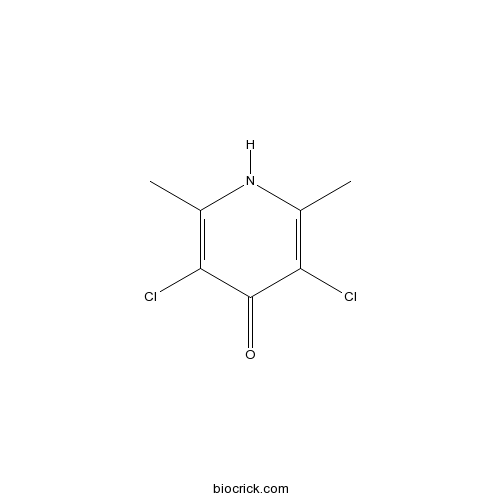ClopidolCAS# 2971-90-6 |

Quality Control & MSDS
3D structure
Package In Stock
Number of papers citing our products

| Cas No. | 2971-90-6 | SDF | Download SDF |
| PubChem ID | 18087 | Appearance | Powder |
| Formula | C7H7Cl2NO | M.Wt | 192 |
| Type of Compound | N/A | Storage | Desiccate at -20°C |
| Solubility | DMSO : < 1 mg/mL (insoluble or slightly soluble) | ||
| Chemical Name | 3,5-dichloro-2,6-dimethyl-1H-pyridin-4-one | ||
| SMILES | CC1=C(C(=O)C(=C(N1)C)Cl)Cl | ||
| Standard InChIKey | ZDPIZLCVJAAHHR-UHFFFAOYSA-N | ||
| Standard InChI | InChI=1S/C7H7Cl2NO/c1-3-5(8)7(11)6(9)4(2)10-3/h1-2H3,(H,10,11) | ||
| General tips | For obtaining a higher solubility , please warm the tube at 37 ℃ and shake it in the ultrasonic bath for a while.Stock solution can be stored below -20℃ for several months. We recommend that you prepare and use the solution on the same day. However, if the test schedule requires, the stock solutions can be prepared in advance, and the stock solution must be sealed and stored below -20℃. In general, the stock solution can be kept for several months. Before use, we recommend that you leave the vial at room temperature for at least an hour before opening it. |
||
| About Packaging | 1. The packaging of the product may be reversed during transportation, cause the high purity compounds to adhere to the neck or cap of the vial.Take the vail out of its packaging and shake gently until the compounds fall to the bottom of the vial. 2. For liquid products, please centrifuge at 500xg to gather the liquid to the bottom of the vial. 3. Try to avoid loss or contamination during the experiment. |
||
| Shipping Condition | Packaging according to customer requirements(5mg, 10mg, 20mg and more). Ship via FedEx, DHL, UPS, EMS or other couriers with RT, or blue ice upon request. | ||

Clopidol Dilution Calculator

Clopidol Molarity Calculator
| 1 mg | 5 mg | 10 mg | 20 mg | 25 mg | |
| 1 mM | 5.2083 mL | 26.0417 mL | 52.0833 mL | 104.1667 mL | 130.2083 mL |
| 5 mM | 1.0417 mL | 5.2083 mL | 10.4167 mL | 20.8333 mL | 26.0417 mL |
| 10 mM | 0.5208 mL | 2.6042 mL | 5.2083 mL | 10.4167 mL | 13.0208 mL |
| 50 mM | 0.1042 mL | 0.5208 mL | 1.0417 mL | 2.0833 mL | 2.6042 mL |
| 100 mM | 0.0521 mL | 0.2604 mL | 0.5208 mL | 1.0417 mL | 1.3021 mL |
| * Note: If you are in the process of experiment, it's necessary to make the dilution ratios of the samples. The dilution data above is only for reference. Normally, it's can get a better solubility within lower of Concentrations. | |||||

Calcutta University

University of Minnesota

University of Maryland School of Medicine

University of Illinois at Chicago

The Ohio State University

University of Zurich

Harvard University

Colorado State University

Auburn University

Yale University

Worcester Polytechnic Institute

Washington State University

Stanford University

University of Leipzig

Universidade da Beira Interior

The Institute of Cancer Research

Heidelberg University

University of Amsterdam

University of Auckland

TsingHua University

The University of Michigan

Miami University

DRURY University

Jilin University

Fudan University

Wuhan University

Sun Yat-sen University

Universite de Paris

Deemed University

Auckland University

The University of Tokyo

Korea University
- Methyl chlorogenate
Catalog No.:BCC9042
CAS No.:29708-87-0
- DOB hydrochloride
Catalog No.:BCC5947
CAS No.:29705-96-2
- dihydrokaempferol
Catalog No.:BCC8191
CAS No.:5150-32-3
- Oxyresveratrol
Catalog No.:BCN5201
CAS No.:29700-22-9
- Ethynodiol diacetate
Catalog No.:BCC4483
CAS No.:297-76-7
- 2-Aminothiazol-4-acetic acid
Catalog No.:BCC8556
CAS No.:29676-71-9
- 13-Oxo-9E,11E-octadecadienoic acid
Catalog No.:BCN8173
CAS No.:29623-29-8
- Friedelin 3,4-lactone
Catalog No.:BCN6449
CAS No.:29621-75-8
- Gynuramide II
Catalog No.:BCN5200
CAS No.:295803-03-1
- 2-Amino-2',5-dichlorobenzophenone
Catalog No.:BCC8520
CAS No.:2958-36-3
- Sakuranetin
Catalog No.:BCN5199
CAS No.:2957-21-3
- (E)-N-Caffeoylputrescine
Catalog No.:BCC8391
CAS No.:29554-26-5
- Dihydro-β-erythroidine hydrobromide
Catalog No.:BCC7341
CAS No.:29734-68-7
- Apigenin-7-glucuronide
Catalog No.:BCN5326
CAS No.:29741-09-1
- Luteolin-7-O-glucuronide
Catalog No.:BCN5338
CAS No.:29741-10-4
- Loganetin
Catalog No.:BCN5202
CAS No.:29748-10-5
- Altretamine hydrochloride
Catalog No.:BCC4114
CAS No.:2975-00-0
- Altenuene
Catalog No.:BCN7392
CAS No.:29752-43-0
- Teniposide
Catalog No.:BCC3864
CAS No.:29767-20-2
- Nudifloside B
Catalog No.:BCN7474
CAS No.:297740-98-8
- Nudifloside C
Catalog No.:BCN7491
CAS No.:297740-99-9
- Silydianin
Catalog No.:BCN2388
CAS No.:29782-68-1
- Carbamazepine
Catalog No.:BCC4378
CAS No.:298-46-4
- Threo-methylphenidate hydrochloride
Catalog No.:BCC5818
CAS No.:298-59-9
Development of an enzyme-linked immunosorbent assay for detection of clopidol residues in chicken tissues.[Pubmed:24395395]
J Sci Food Agric. 2014 Aug;94(11):2295-300.
BACKGROUND: Clopidol is mainly used for the prevention and treatment of coccidiosis, which poses a serious potential hazard to public health, in veterinary medicine. The aim of this study was to prepare monoclonal antibodies (mAbs) against Clopidol (CLOP) and develop an immunoassay for detecting CLOP residues in chicken tissues. After derivation, CLOP hapten was conjugated to carrier proteins to synthesize the artificial antigen, and immunized Balb/C mice were employed to screen mAbs. RESULTS: A sensitive hybridoma named C1G3 was screened out and two indirect competitive enzyme-linked immunosorbent assay (icELISA) standard curves were established. For the traditional two-step assay the linear range was from 0.06 to 98 ng mL(-1) , with half-maximal inhibitory concentration (IC50 ) and limit of detection (LOD) values of 2.76 ng mL(-1) and 0.03 ng mL(-1) respectively, while the rapid one-step icELISA had a working range from 0.08 to 102 ng mL(-1) , with IC50 and LOD values of 3.52 ng mL(-1) and 0.03 ng mL(-1) respectively. It was also indicated that a 10-fold dilution in chicken muscles gave an inhibition curve almost the same as that obtained in phosphate-buffered saline. When applied to spiking tests in chicken samples, the correlation coefficient (R(2) ) between concentrations added and measured was 0.9534. CONCLUSION: The results of this study suggest that the immunoassay described is a promising alternative for screening CLOP residues in biological matrices and is suitable for routine diagnostics.


